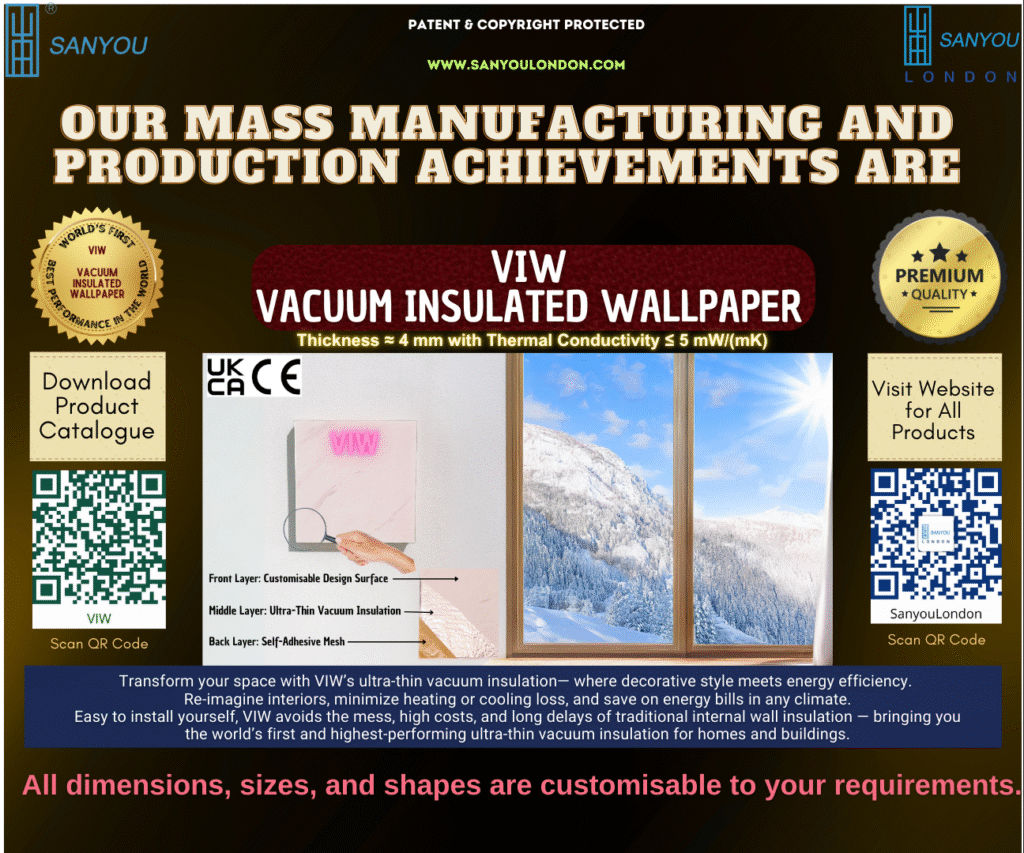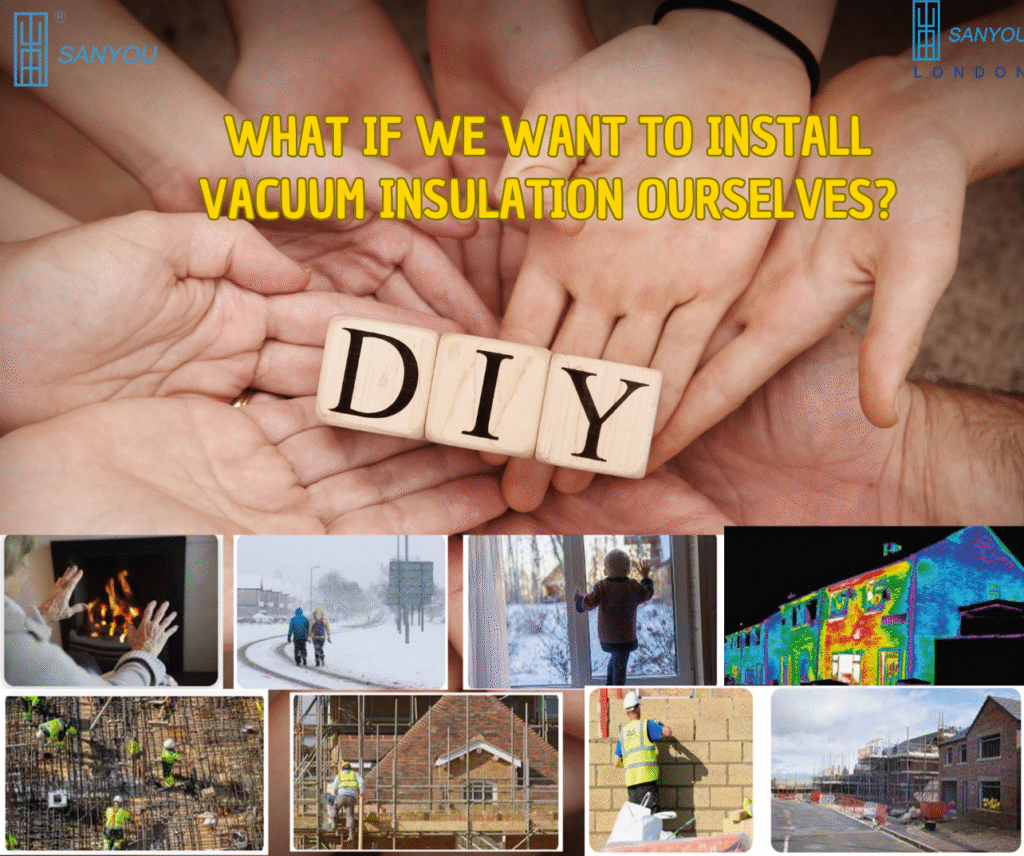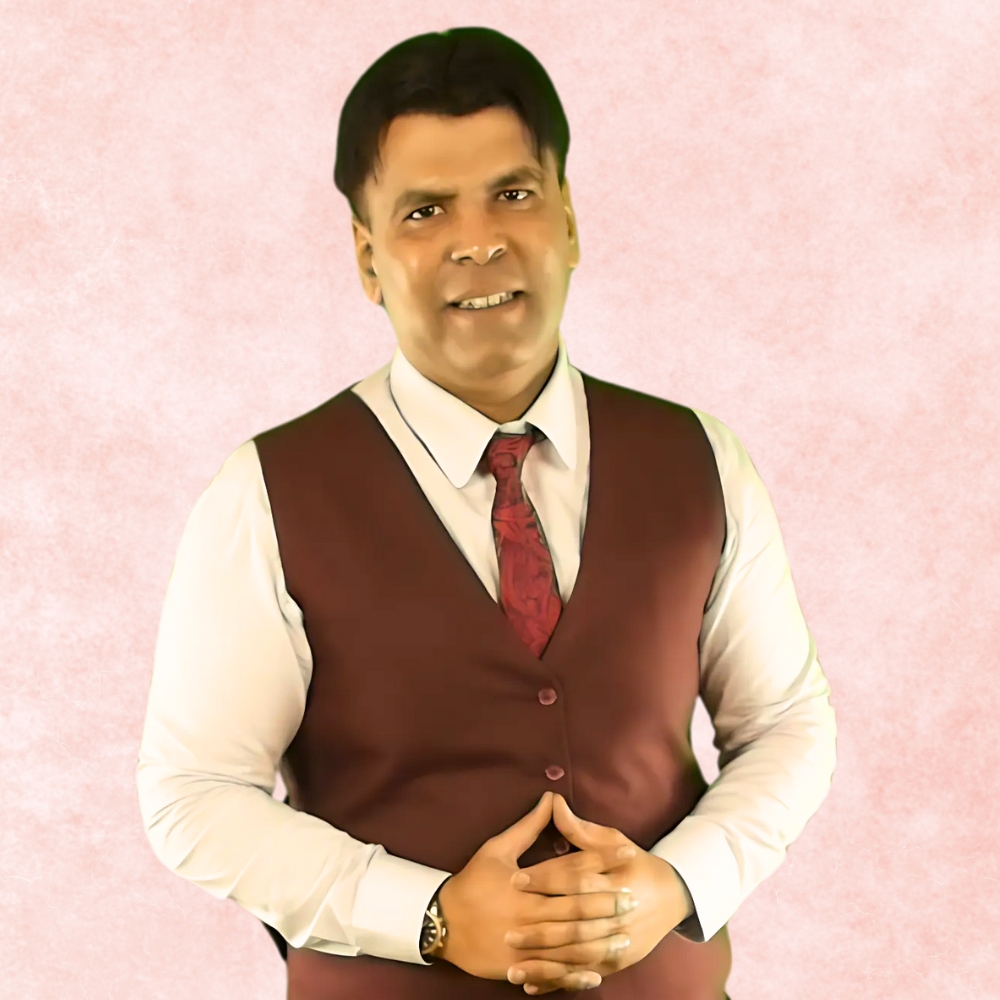
Vacuum Insulated Wallpaper (VIW): A DIY Home Insulation Innovation for Affordable Energy Savings—No Expensive Contractors, and a Clear Path Toward Net-Zero Homes
Let’s keep this as a conversation rather than a brochure. We all hear “climate change”, “sustainability”, and “energy efficiency” every day. Too often, the ideas stay in reports while bills keep rising. My team and I focus on delivery: practical products that let households take control of energy use, without upheaval or high contractor costs.
Why do we need Vacuum Insulated Wallpaper (VIW)?
Three stubborn problems keep showing up.
- Rising energy costs. In the UK and similar cold, arid climates, gas and electricity bills strain household budgets. In the Middle East, cooling loads push electricity use year-round.
- Poor insulation in existing homes. Much of the housing stock leaks heat in winter and loses cooling in summer.
- High retrofit costs and disruption. Traditional insulation often means contractors, mess, and weeks of work—so upgrades get postponed.
VIW exists to change that: a slim, decorative, do-it-yourself upgrade that measurably cuts heat loss and helps stabilise room temperatures.
What is special about VIW—and can it really lower my bills?
VIW is the invention of Professor Saim Memon from TRL1 to TRL9, it is around 4 mm thick with a thermal conductivity < 5 mW·m⁻¹·K⁻¹. In simple terms, lower conductivity means better resistance to heat flow—so your walls lose less warmth in winter and admit less heat in summer.
A quick, concrete example (one square metre):
- External wall: single brick, 215 mm thick with k ≈ 700 mW·m⁻¹·K⁻¹.
- VIW: 4 mm, k ≈ 5 mW·m⁻¹·K⁻¹.
- Combine the layers properly (adding thermal resistances), and the equivalent conductivity of that 219 mm composite becomes ≈ 198 mW·m⁻¹·K⁻¹.
- That is a 71.7% reduction versus brick alone—a significant improvement in insulation.
If you prefer the U-value view: the wall’s U drops from about 3.26 W·m⁻²·K⁻¹ to 0.90 W·m⁻²·K⁻¹ on that square metre—less heat leaking out, less money lost.
How much energy could VIW save?
Using the same one-square-metre example with realistic, rounded assumptions:
- UK heating season: about 160 days per year
- Temperature difference: 20°C
- Energy saved: ≈ 180 kWh per year per m²
- At 22p/kWh: ≈ £40 per year per m²
Results vary with wall type, air-tightness, solar gains, internal set-point, and use patterns, but the order of magnitude is clear.
What does VIW cost—and when does it pay back?
- VIW comes as 200 × 200 mm sheets; 25 sheets cover 1 m².
- Indicative cost: ≈ £150 per m² (design, customisation, and quantity affect pricing).
- Simple payback: ≈ 3.75 years at £40 per m² per year savings—after that, it keeps paying you back.
In hot-arid regions (UAE, Saudi Arabia) where air-conditioning runs most of the year, the same mechanism works in reverse—reducing cooling load—so payback can be even shorter.
Who installs VIW—and why does DIY matter?

You do, with basic tools. And that changes the economics. Many “cheap” materials become expensive once you add labour, site time, and disruption. VIW avoids contractor overheads while delivering high thermal performance in minimal thickness.
How VIW works (plain-English version)
A vacuum is a superb barrier to heat transfer. VIW uses ultra-thin vacuum-insulated panels concealed within a decorative surface. The result is a slim, good-looking layer you can apply to selected cold walls, reveals, or entire rooms.
DIY installation—simple, careful, and tidy
Before you start
- Choose dry, sound walls; fix damp issues first.
- Plan your layout so 200 × 200 mm sheets stagger neatly and services are avoided.
- Gather tools: straightedge, knife, roller, suitable adhesive, finishing trims, and a spirit level.
Step-by-step
- Mark out the grid and check for level at skirtings and corners.
- Apply adhesive per guidance; aim for full-surface support.
- Place sheets firmly; avoid bending, and do not pierce the panels.
- Stagger joints; work across the wall; keep gaps consistent.
- Finish with matching trims or cover layers as specified.
Good practice
- Avoid fixings that penetrate the panel.
- Coordinate sockets and switches—shift the backbox position or bridge around with trims.
- Seal perimeters neatly to limit air movement behind the lining.
If you are unsure about a specific substrate or detail, ask us—we provide design notes and phone support.
Where should I use VIW—and where should I avoid it?
Ideal
- Cold north-facing external walls, bay returns, and window reveals
- Box rooms or home offices that feel chilly
- Flats where external insulation is not permitted
Avoid or seek advice first
- Active damp, condensation, or mould—fix root causes before lining
- Areas needing frequent mechanical fixings through the lining
- Unusual fire or hygiene requirements—request the appropriate finish
Will it improve comfort and property value?
Yes. Users typically report fewer cold surfaces, quicker warm-up, and more stable room temperatures. Better thermal performance supports an improved EPC outcome, and in refurbishments that can translate into higher asset value.
Quick answers to common questions
Can I decorate over VIW?
Yes—choose from our decorative finishes, or apply compatible cover layers as specified.
Is it safe around heat sources?
Maintain clearances per appliance guidance; ask us for details if you plan to line behind radiators or stoves.
What about fire performance?
We specify finishes and build-ups for the intended room type; if you need specific classifications, we’ll advise suitable configurations and share test data on request.
What maintenance is required?
Treat VIW as you would a high-quality wall finish—wipe-clean options are available.
Can I see the numbers for my room?
Yes—share wall build-ups, dimensions, and temperatures; we’ll provide a quick U-value and savings estimate for your case.
The bigger picture—vacuum insulation and net-zero homes
Net-Zero Energy Buildings aim for balance—generation offsetting consumption. If heat escapes through walls, you need more generation to stand still. Vacuum insulation tackles the loss directly, so your future solar array and battery do not have to work as hard.
Ready to try VIW—or want a quick call first?
- Contact our Customer Service Team for samples, pricing, installation notes, and room-by-room guidance.
- Prefer a direct conversation? Reach out to Professor Saim Memon by email or phone—we’ll talk through your rooms, your budget, and the quickest path to results.
- Explore products, specifications, purchasing, videos, and FAQs: www.sanyoulondon.com
VIW helps households act today: slim, decorative, and genuinely effective. No drama; no scaffolding; just a practical step toward warmer winters, cooler summers, and lower bills.
Share

Author
Prof. Dr. Saim Memon
PhD, CEng, FHEA, MSc, BEng(Hons), PGC-TQFE, GTCS, MCMI, MIET, MIEEE, MInstP, IBPSA, APCBEES, MPEC
CEO | Industrial Professor | Inventor | British Scientist | Chartered Engineer | Qualified Teacher | Chief Editor | World Speaker | Pioneer in Vacuum Insulation Energy Technologies

